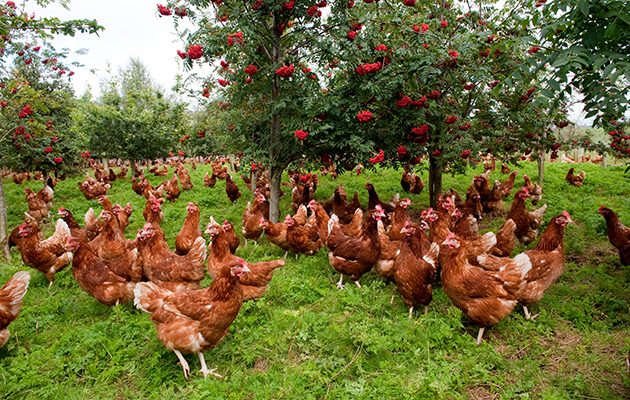It is vital that our hens are free range. Not only does this ensure golden yolks and happy hens, but it also helps wild birds, bees and the environment, says Tim Field
Free range hens ensure rich, golden yolks for breakfast – and they also help wild birds, bees and the environment, says Tim Field.
For more on farming, learn about the importance of the muck heap in the battle against soil depletion in muck heaps: the best of muck.
FREE RANGE HENS
The sight of a deep, rich, almost orange yolk on a soft-boiled egg at breakfast time gives comforting warmth. For me, it is reminiscent of an egg born to a free-spirited farmyard hen, possibly laid in the flower bed, most likely the product of a muck heap rummage, a graze in the veg patch and a peck at the horse feed. Contrast that with the anaemic, bland, nondescript supermarket egg from an undisclosed source. To many, the quality of an egg says a lot about the life of a hen, demonstrated by booming sales of eggs labelled higher welfare.
Giving hens the opportunity to range isn’t just in the interest of product quality – it’s also about building a healthy flock. In 1999, an EU Directive acknowledged the poor welfare standards of conventional battery cages and by 2012 they had all been superseded by “enriched cage” or “barn reared” systems. Whilst improved, the eye-watering whiff of poultry manure still doesn’t inspire me with confidence in what lies behind the barn door, whereas the sight of free-ranging chickens instantly reveals a higher welfare enterprise.
Outdoor ranging is important for hen welfare; it promotes natural behaviours and detracts from injurious feather pecking. Our 30-acre hen field is broken into nine ranges, each split in two with a house and chickens occupying one half. The houses move back and forth annually giving plenty of clean pasture for more than 13,000 hens in residence. In a fallow year, the enhanced soil fertility is mopped up by rotating crops of kale and Brussels sprouts grown by the horticulture team. This system works well but there is room for improvement so plans are afoot to be more dynamic and utilise the field better.
Enhancing the range habitat further would encourage hens to scatter, thereby dispersing nutrients, avoiding parasitic build-up around the houses and reducing poaching to leave cleaner eggs. Next March we will leave the kale to go to flower and set seed – long after the last leaf is harvested – so when the house returns to that half of the range there is a ready-made cover crop. The shelter and alternative food source will encourage the birds to explore all extremities of the range. Flowering brassicas are also welcomed by the bees and a few acres can be a significant addition to the honey yields. Wild bird populations can enjoy the seeds and bugs that cover crops harbour, and there are additional benefits for the hens from supplementary nutrition emerging in the range.
A four-year kale rotation will only suit half of the occupied ranges at any one time, so thoughts turn to perennial options that farm the vertical – trees and chickens are inherently suited. We are in prime pomme country and nine rows of apple trees would be a significant contribution to a 7,000-litre cider enterprise or a new venture into juice. However, these exposed Cotswold slopes have stinging spring winds that can decimate fruit tree blossom so further shelter is called upon. Thankfully, the 910kW biomass boiler has an insatiable appetite for woodchip so shelter belts of fast-growing willow and hazel coppice bring additional benefits beyond ranging chickens and fruit blossom. Woodchip will also be readily available for hen house and livestock bedding, the willow could be used for cattle fodder and by selecting a species with flowering pussy willow interspersed with holly and other shrubs adds to the bees’ larder and complements the cutting garden for wreath making and floristry. Then along come the country craftsmen, eyeing up the long, straight poles for hedge-laying stakes and binders, pea sticks and wattle fencing.
The 30-acre plot is due to get busy but the environment will only improve. The trees will fix more carbon, build soil organic matter, provide shelter, improve rainwater infiltration, reduce soil erosion, increase biodiversity and look stunning. Thankfully, tree management doesn’t demand a perfect window of weather, you just have to be hardy. Much of the work required to plant, chop, chip, prune, harvest, sculpt and lay is going on when the tractors are put to bed and the stock close to home over the winter. And the political climate is perfect to turn to agroforestry. The Woodland Trust is geared up to issue grants and Mr Gove is keen to catch up on the Government’s pledge and plant 11 million trees by 2020. As with the rise of pasture-fed beef and lamb, woodland-reared hens are making a charge in the market. It’s up to an enterprising farmer how best to sweat those by-products but, ultimately, there has never been a better time to get out and plant a whip.
Follow Tim and Agricology @agricology





